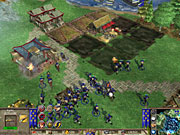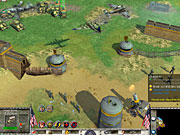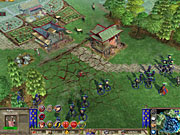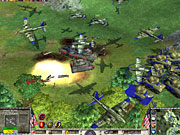Rather like that age-old wargame, chess, real-time strategy games abstract the nature of war, reducing the deadly action and the huge industrial investment into a contest that can be decided in a half-hour multiplayer match. But Empires: Dawn of the Modern World decidedly heads in the direction of historical specificity. The latest game from the designer of the original Age of Empires and Empire Earth isn't a reinvention of the traditional RTS formula, but it has the particular distinction of having nine civilizations that play in radically different ways, each with unique special powers, units, and economic traits. Focusing in on five war-torn periods from the time of medieval knights through World War II, Empires provides a look at how military tactics changed in the centuries leading up to the modern era, and the resulting action can pack a lot of units into fierce combined-arms battles. Simply put, there's a lot for RTS fans to like in Empires.

Empires refines the millennia-spanning scope of Stainless Steel's Empire Earth down to its core. The studio's previous game featured a whopping 15 different time periods, from the cavemen to a sci-fi scenario, which, among other things, greatly extended the playing time for full multiplayer matches. The new game trades this massive scope for intricate depth and detail. Yet, it is rather similar in style. The verbose detail and dramatic flair of the campaign cinematics and documentation betray the fact that there was a history buff pulling the strings. Apart from fantastical powers that give a few early units extra punch and a distinctive cardlike system for national abilities, the game plays the historical setting pretty straight, which does help it stand out from Ensemble's Age of Mythology just as the great modern tank and plane combat separates it from Age of Empires II.
With this lineage and refined design approach, Empires takes it quite for granted that players have played real-time strategy games before and know the genre's conventions. The manual starts off saying as much, and there's no tutorial to walk you through the basics. The three single-player campaigns are also designed more to offer a real challenge of their own rather than presenting lessons in how to play skirmishes against the computer or online opponents. In fact, the campaigns seem to go out of their way to avoid the build-a-base-and-annihilate-all-enemies formula common to earlier generations of RTS games.

Each of the three campaigns is available from the start and roughly equal in difficulty. Set during the game's medieval, gunpowder, and WWII periods, the campaigns cover moments in history--Richard the Lionheart's defense of England's crown and lands in France, Korea's resistance of a series of 16th-century Japanese invasions, and General Patton's push through North Africa and France--when battlefield leaders beat the odds and changed the path of nations. Things do start slowly, with rather long-winded in-engine cutscenes used to introduce eminent historical personages, but the missions do trace satisfying character-driven story arcs laced with subterfuge and setbacks. All three are carefully scripted and offer distinct mission styles that give a feel for the difficulties facing the military leaders, who usually take charge and jump into the fighting as hero units. Richard spends quite a bit of time riding around the maps to raise troops from scattered towns that remain loyal to him. The Korean missions (including a dramatic recreation of the naval battle that turned the tide) force you to retreat on occasion, but contain clues on puzzle-laden paths to payback. WWII offers the biggest and best battles of the three, most notably a D-Day scenario.
You might not get a good sense of Empires' four-resource economic model in the single-player missions. Many not only severely limit the types of units you can build to match the circumstances, but they even do away with resource gathering altogether, forcing you to rely on hero units, conscripted reinforcements, and/or defensive options, like booby traps and bomb units. There are chances to appreciate the nations' particular abilities, such as the Koreans' ability to gain citizens by raiding enemy camps and killing works and England's mining camps, which free up workers by producing gold or stone on their own (but not food or wood). But rest assured, all the conventions are, at the core, ready for skirmishes. Just as in Age of Empires, you'll gather wood by sending workers to harvest apple trees, hunt animals, farm, or fish. And all nations--except the Franks and the Germans--have to build houses to increase the population limit.
As if to replicate the upheavals of the modern era, Empires is divided roughly in half for full-length skirmish matches. Between the third (imperial) age and the fourth (World War I) age, a window pops up asking you to choose one of five nations that participated in the World Wars: the United Kingdom, France, Germany, Russia, or the United States. The choices available vary depending on which of the early nations--China, Korea, France, or England--were picked. But once the choice is made, most signs of this earlier era simply disappear, and the building graphics, interface visuals, and economic abilities take on the new national character. Units and purchased upgrades do carry over throughout all the period transitions. Only selected units can be upgraded with the press of a button, and, as a result, you'll see medieval sword infantry running alongside Napoleonic grenadiers or horse cavalry next to tanks. In one case, this seeming anachronism even presents a realistic balance, as WWI-era Russia can build mounted Cossacks or antitank guns but not early tanks. Mostly this means you have to build with progress in mind, and you'll have to turn to the game's cardlike system for upgrades and powers to get extra bang for your buck.

In addition to a few inherent abilities and unique unit powers, the nine nations are differentiated even further by the university, the armory, and the "classified projects" and "innovations" that can be researched. These single-use researches are displayed at the top of the screen and can generally be purchased once for every age advanced, making it possible to hoard them for critical moments. Much like god powers in Age of Mythology, classified projects are powers with large-scale effects, such as revealing enemy locations, healing all friendlies, fomenting rebellion in enemy ranks, or calling in damaging storms. In contrast, the innovations are specific to unit types--enhancing hit points, firepower, or range--and lend them an edge that really is noticeable when combined with numbers.
At first glance, the nations seem amazingly different, each with its unique powers and units. To keep the sides in balance, the resource prices have been tweaked quite a bit. As a result, the Russians might pump out lots of weak conscripts--which can be built amazingly fast once "Steamroller" is researched--to harass the German war machine and preempt getting overwhelmed by a wave of very expensive and very strong King Tiger tanks. While the documentation focuses on background history and lists powers in detail, there are national characterizations that underlie the design. The Chinese can take advantage of mobile Mongol barracks and town halls, Korean units have a martial arts power-up that can be temporarily triggered, the early Franks (and later French) are particularly good at scouting and defensive structures, and the United States is the only nation with nukes. However, for all the differences, all sides get functionally similar classes of units, and a number of early powers reappear in the modern nations with different names.
Empires is designed from the ground up to offer plenty of options in skirmish and multiplayer matches, including two separate modes of play. The "action" mode is intended for shorter (30 minutes or so) matches. It forces constant expansion by allowing you to put lots of workers on small resource clumps, while it decreases the effectiveness of defenses. The "empire builder" mode, on the other hand, promotes settling in and climbing up the tech tree. Plus, it's already seems popular to restrict a match to either the early or later ages, and it's possible to customize the population limit into the thousands per map to produce truly huge battles. Like some other recent RTS games, the multiplayer ladder is based on matches that anonymously and automatically pair players of similar rank, but at this early date it can take quite some time staring at the waiting screen to find a match this way.

This is one of the first strategy games to flaunt fancy DirectX 8 and 9 visual effects, which creates some superbly realistic water and nice weather effects. Of course, it's a fully 3D game, and it's possible to rotate the camera in any direction or to leave it alone, locked in the standard and efficient top-down view. When fierce land, sea, and air battles are raging, the game looks quite good, but by themselves, the environments and units are rather plainly textured. The unit animations are also quite awkward looking. As a result, the close-up cutscenes that frame the single-player story are far from the best-looking part of the game. The production values fall down in other areas, particularly the extensive voice acting, which is done in uneven accents for every nation and is only rarely acted well enough to overcome a dry and overly expository story script. Little of the audio stands out and the score is unremarkable, but sound effects are used in a creative code, in the place of conventional voice chatter, to signal the completion of queued units. On the technical front, the pathfinding is somewhat erratic, but the gameplay style is generally so hands-on and focused that it's not a problem.
Without trying to reinvent a successful gameplay formula, Empires' ambition lies in featuring nine nations that are as different from one anther as possible without destroying the careful balance necessary for good multiplayer competition. The design puts well-recognized historical action into play and makes believable use of the material, while adding some powerful spell-like effects to keep the action interesting. While it may not have the breadth of Rise of Nations' real-time empire building, the tight scope deals out dividends when it comes to fast-paced battles. As a refinement of the Age of Empires legacy, Empires offers enough that's new to even appeal to those who aren't card-carrying RTS fans.